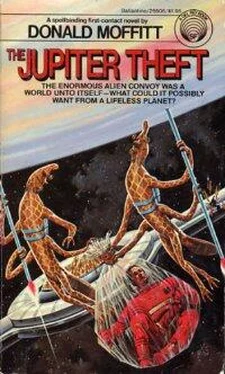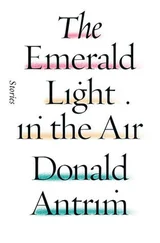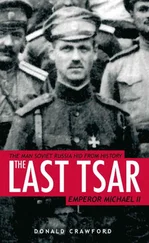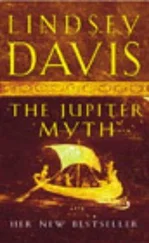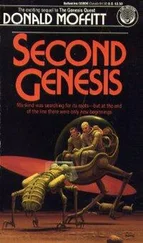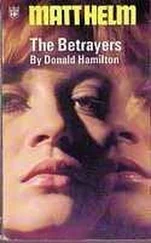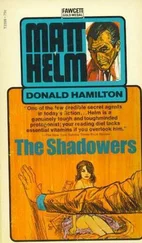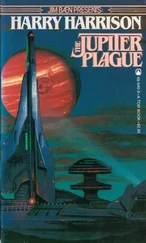The number of possible phonemes in the Cygnan language was staggering. They were based on the absolute pitch of a tone—not relative pitch, like the rising and falling tones of Chinese. The Cygnans had a useful range of two and a half octaves, and they could divide each twelve-tone octave into quarter-tones.
That made 120 phonemes to start with.
Just the single notes!
But a phoneme might be a single note, any combination of two notes, or any combination of three notes.
How many different two-note combinations were there? Jameson worked it out in his head. More than seven thousand of them.
Jameson became discouraged at that point. He didn’t bother to figure out how many different three- note combinations there were. Or what happened when you figured in all the extra little slides and turns that Cygnans seemed to use the way humans used double consonants. It was depressingly clear that the number was astronomical. Compared with the paltry few dozen phonemes available in human languages, the richness of the Cygnan language must be beyond belief!
Perhaps, Jameson speculated with a sudden rush of awe, the Cygnans could even convey visual information with their language directly, in the same way dolphins could show one another the shape and depth of a bay by sonar imitation.
Actual pictures, built up of digital bits formed of sound, transmitted as naturally as breathing from Cygnan to Cygnan! Not descriptions, such as: “I see a creature with only four limbs and no tail, about so big.” But: “I see a creature that looks like this. ”
In human terms, Jameson thought, how many thousands of words would it take to teach someone, say, a tune by Beethoven? How much simpler just to hum it. And a tune, compared with visual material, was a straightforward linear piece of information containing relatively few bits.
He tried not to worry about it. The most rudimentary sort of pidgin Cygnan would have to do. After all, he consoled himself, South Sea islanders had managed to trade with the first British mariners using a few dozen basic nouns and modifiers. It hadn’t been necessary for them to learn the language of Shakespeare.
Slowly, painfully, tone by tone, hoping the two Cygnans’ patience would last, Jameson acquired the first dozen words of a vocabulary that consisted mostly of parts of the body and a few objects in the room. Next he tried an abstraction. What did the Cygnans call their race? What class of creatures, he asked them, included both Tetrachord and Triad?
He made the sounds of their names, followed by the Cygnan-style inclusive gesture, and ending with the little trill he had come to recognize as a Cygnan interrogative. He was rewarded with a burst of harmony. In five minutes he learned to repeat this as arpeggios, and the Cygnans warbled their approval.
An aproned assistant arrived at that point to put another of the pyramidal cages on the desk. The Cygnan apron, worn lengthwise, was anchored by a loop over head and tail, with a scalloped leathery flap hung down either side.
Jameson thought he’d clinch it. Before the assistant could leave, he made the inclusive gesture for all three of the Cygnans and repeated his question.
There was a lot of agitated chirping. Then Tetrachord and Triad both turned to him and gave him an entirely different word.
Jameson wiped the sweat off his forehead with a forearm. What was going wrong? He decided to attack it from a different angle. What did the Cygnans call humans?
“Ja-me-son,” he said in the three-note figure that signified his name. Then he made the inclusive gesture and whistled, “Ja-me-son, Ja-me-son,” followed by the interrogative trill.
What are many Jamesons called? He waited.
He got his own name back firmly, once, There is no such thing as a class of Jamesons. He tried again, and got his name back with the cascade of dropping thirds that they always used to correct him with. A mistake. Evidently such a thing as many Jamesons was a conceptual impossibility.
Doggedly he tried again. Numbers, then. Numbers were basic. He held up a finger. “One.” He extended another. “Two.” He added a third. “Three.” Then he trilled the Cygnan interrogative.
He waited. Nothing.
He tried again. “One…”
The smaller Cygnan, Triad, was showing signs of becoming restless. She—why did he think of this one as she?—turned to Tetrachord and tootled at him. Tetrachord tootled back. Then he slithered off his perch and picked up the electric prod. He gestured toward the door with it.
It was time for Jameson to go back to his cage.
He rose to his feet reluctantly. He hadn’t made much progress. Would he get another chance? Cygnans didn’t seem to be long on patience. Or curiosity.
If only he could speed up the process of communication.
He allowed them to herd him halfway to the door before he stopped. Then he became stubborn, earning himself a mild tingle from the prod.
Moving slowly so as not to alarm them, he started toward the untidy stack of human goods over at the far wall. They did nothing to stop him. He was able to reach the Moog.
He turned it on. The little red light glowed. There were still a couple of dozen hours left in the batteries. Quickly he pulled out stops, trying for an approximation of the Cygnan voice. A touch of oboe. A flute. A bassoon with its wave frequency moved up to the treble range. A synthetic soprano voice saying “ ah. ”
The preparation took him a few seconds. He glanced over his shoulder. How much time would they allow him? Not enough time to reprogram the little computer that was the heart of the Moog; that would take hours. But he didn’t have to do anything very complicated to start with. He altered the tuning of the A to shift it slightly from concert pitch, and the Moog obligingly shifted the rest of the scale to go with it. Then he lowered all the C sharps a trifle and retuned a couple of the notes he wouldn’t be using for the demonstration, to provide the quarter-tone notes he would need.
He turned. Triad was coming toward him, hissing. Her rasplike tongue flickered in and out. His time was up.
Jameson put his hands on the keyboard and said her name in perfect Cygnanese. With, he hoped, hardly a trace of an accent.
He worked on the Moog while the assistant brought in their lunch. He didn’t care to think about the Cygnans’ lunch except to note that it didn’t seem to enjoy being eaten. His own lunch was another half-thawed block of food from his own ship’s freezer—this time a pie-sized portion of mincemeat stuffing intended for Christmas dinner.
The Moog had two five-octave keyboards. He compressed them into a single compass of two and one half octaves composed of quarter-tones. It fit the Cygnan vocal range perfectly.
He fiddled individually with what seemed to be some of the more important tones in the Cygnan vocabulary—the off-key B flat in Tetrachord’s name and the wrong-note bagpipe tone that finished off the octave, among others. But for most of it he simply had the computer chop up the normal equal-temperament octave into forty-eight pieces instead of twelve. He could retune other crucial notes one at a time as they came up while he was learning to talk Cygnan.
It took him another hour to alter the Moog’s memory so that it would replay some of the standard Cygnan sequences at the touch of a button—the interrogative trill and the cascade of minor thirds, and some of the turns and arabesques he’d been able to pin down so far. He had only to play them once through and tell the Moog to remember them. They were plugged into the bank of cheater buttons that were meant for slipbeat rhythms and computer-generated contrapuntal voices.
When he’d finished, not even Johann Sebastian Bach could have played recognizable human music on the Moog. It was a Cygnan speech synthesizer now, with lots of unused learning capacity.
Читать дальше
